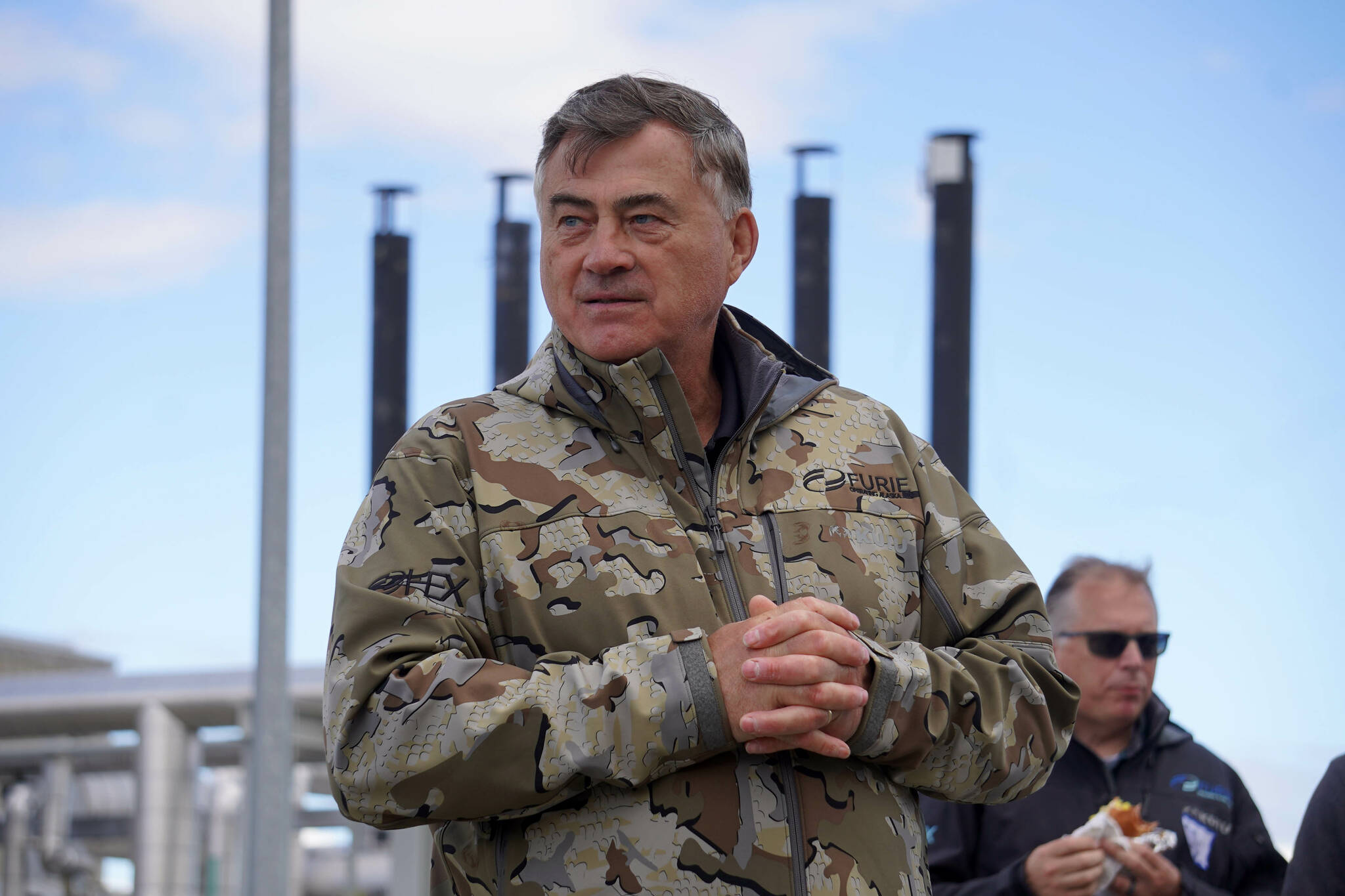Spectators gathered at Furie Operating Alaska’s central processing facility in Nikiski last week, on July 10, to witness a test flight for a drone operating beyond visual line of sight. The aircraft traveled from Nikiski to a platform in Cook Inlet and returned with cargo.
Furie says the technology may allow for routine deliveries to and from the platforms at reduced cost and increased human safety.
The drone has a wingspan of a few feet, weighs about 55 pounds and flies around 60-70 miles per hour. It performs vertical takeoff and landing using propellers before converting in the air to a fixed-wing aircraft.
The test flight tasked the aircraft with flying around 17 miles, taking around 30 minutes in both directions.
JR Ancheta, project manager at the University of Alaska Fairbanks’ Alaska Center for Unmanned Aircraft Systems Integration, said the drone can fly for around five to seven hours powered by both battery and gas tank. To accommodate Alaska’s cold temperatures, it charges its battery while flying.
“It’s a pretty neat machine,” he said.
Furie is owned by HEX Cook Inlet. The company’s facility in Nikiski is connected by a 15-mile pipeline to a platform in the inlet. At the facility, natural gas is taken in via the pipeline and is processed by removing water vapor. Then, it’s sold to utilities on the Kenai Peninsula and Alaska’s Railbelt.
As part of Furie’s requirements for operating in the inlet, HEX Cook Inlet President and CEO John Hendrix said, they have to send water samples to the state. Those samples historically have had to be either transported by helicopter or moved using the gas pipeline like a pneumatic tube — which means breaking the pressure, bleeding down the lines and extracting the bottles.
Hendrix said they started working with ACUASI and the RTX Corporation to seek an alternative solution to that “immediate need.” He said he thought they’d be doing flights with the drone years ago, but it was a long road, “a three-year wait,” to acquire the approvals to test the technology from the Federal Aviation Administration.
To complete the test last week, the drone flew out to the platform and landed, there picking up those same water samples before returning to the Furie facility.
Present for the test were Rep. Justin Ruffridge, R-Soldotna; Soldotna City Manager Janette Bower; and representatives for Gov. Mike Dunleavy and U.S. Sens. Dan Sullivan and Lisa Murkowski.
“We want to prove that we’re able to do this safely, because that’s what the FAA really cares about — the safety of the airspace,” Ancheta said. “Once we prove to them that this concept is viable, then we can transition to having Furie do this operation using the drone.”
Though the water samples were an obvious and regular use case, Hendrix said drones could also be used to deliver emergency supplies or fulfill other needs.
Furie Operations Engineer Hunter Van Wyhe said the test was just the first step at seeing drone technology more widely used not just at the Nikiski facility or in oil and gas, but more broadly throughout Alaska. Moving forward, he said they’ll continue to test and improve the flights in collaboration with the university. The ultimate goal is to see them regularly used as a tool.
“We’re not trying to replace helicopter usage,” Van Wyhe said. “We’re just trying to supplement it for small, critical, time-sensitive materials.”
The drone was piloted last week by two people, though Ancheta said it completes much of its route automatically. In Nikiski, chief unmanned aircraft systems pilot Jason Williams guided the drone through takeoff, then carefully monitored it as it set out over the inlet.
Ancheta explained that as part of the FAA approval, the aircraft must give a wide berth to other objects in the sky and on the water. While the drones are flying automatically, the pilots can redirect to accommodate birds, boats or anything else of note.
When the drone was around halfway to its destination, Williams rose from his computer and passed off remote control of the drone to another pilot, located on the platform in Cook Inlet.
When beyond line of sight, the drone communicates with a large radar tower provided by RTX that tracks its location as well as seeks out birds and drones.
Mike Dubois, of RTX, explained that the radar doesn’t get along well with large metal structures — like oil platforms — which is why a pilot has to take control at either end of the route and perform the landing and takeoff. From his workstation, Williams could see that radar feed, as well as video of the water sent back from the drone. He stepped out of a trailer where his gear was set up at both the start and end of the test to guide the drone up or down using a handheld controller.
Only an hour after departing Nikiski, the drone returned. Through the cloud of dust its propellers kicked up, a pair of small water bottles could be seen affixed to the underside of either wing.
This story was corrected Thursday, July 18, to remove a claim by engineers that the test flight was the first commercial operation of a drone in Alaska’s oil and gas industry. Enchantment Aviation said Thursday that the first commercial drone flight was undertaken by ConocoPhillips in Fall 2013.
Reach reporter Jake Dye at jacob.dye@peninsulaclarion.com.


